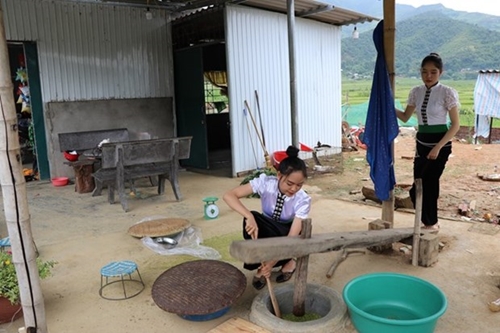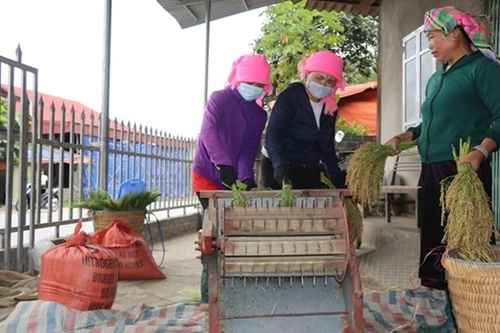The Tu Le sticky rice flakes is the perfect combination of the nature and skilled hands of Thai ethnic minority people in Yen Bai.
    |
 |
|
In order to make “com” with original flavor, Thai people process a sophisticated procedure. |
In October, when terraced fields in Na Loong, Pom Ban, Ban Com, Pung Xom villages of Tu Le commune in Van Chan district and those in Lim Mong and Lim Thai villages of Cao Pha commune in Mu Cang Chai district enter the end of harvesting season, local residents start to make “com.”
The Tu Le valley is surrounded by three mountains of Khau Pha, Khau Than and Khau Song. It is famous for its Tan sticky rice – which is similar to rice made from nowhere.
Scientists held that the nice taste of the rice comes from the year-round cool weather in the area with great difference in temperature in daytime and at night, which leads to high energy reserve of rice grown in the area.
At the same time, the soil of Tu Le is rich in humus and minerals, coupled with fresh water from the stream flowing from the top of Khau Pha pass also among the natural factors that create the special flavor of Tu Le sticky rice.
This particular grain of rice has large, round seeds and when it is cooked, the rice has a special soft and fragrant taste. When it is processed into “com,” it tastes sweet and pleasant and has a unique green color.
This specialty is not only made from the quintessence of the nature but the love and soul of local residents.
In order to make “com” with original flavor, Thai people process a sophisticated procedure.
The rice for making “com” must be harvested at the right time when the grain is not fully ripened. The harvesting activities are conducted at night when the rice is still soaked with night dew. After bringing them home, Thai people will roast the grain right away to fully maintain its green color and sweet and delicious flavor.
They use firewood stove to roast the grain. The roasting pan is usually made of cast iron to ensure that the sticky rice is not overcook and remain sticky.
The roasting process takes about 30 minutes. After that, the grain is pounded in the stone mortar to soften the grains, which also demands typical technique and experience.
    |
 |
|
The rice for making “com” must be harvested at the right time when the grain is not fully ripened. The harvesting activities are conducted at night when the rice is still soaked with night dew. |
The process of pounding the nuggets must be even, continuous and rhythmic so that the pounding power is not too strong or too light. At the same time, another person used a piece of bamboo to stir the rice in a mortar to discover husk. When he saw the husk, he removed it and then pounded it again.
Hoang Thi Sang, a local in Na Long village of Tu Le commune, said the stages of making “com” are complicated. At the start of Tu Le nugget season, the villagers start to harvest the rice from 5 a.m. and then only the newly ripe rice are carefully selected to make delicious nuggets.
Currently, all villagers in Tu Le commune are involved in producing nuggets. Each local family can make around 20kg per day. Each kilo of Tu Le nuggets could be sold at 100,000 VND (4.4 USD), which has become their major source of income.
Today, “com” has become a cultural symbol of Tu Le, a must-try specialty of the mountainous land.
Source: VNA